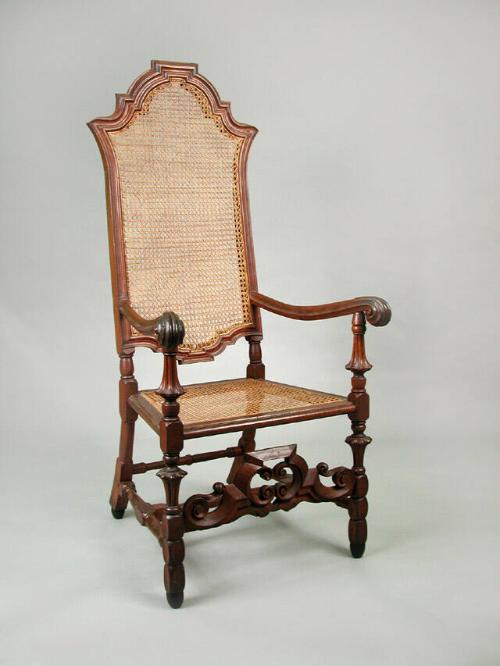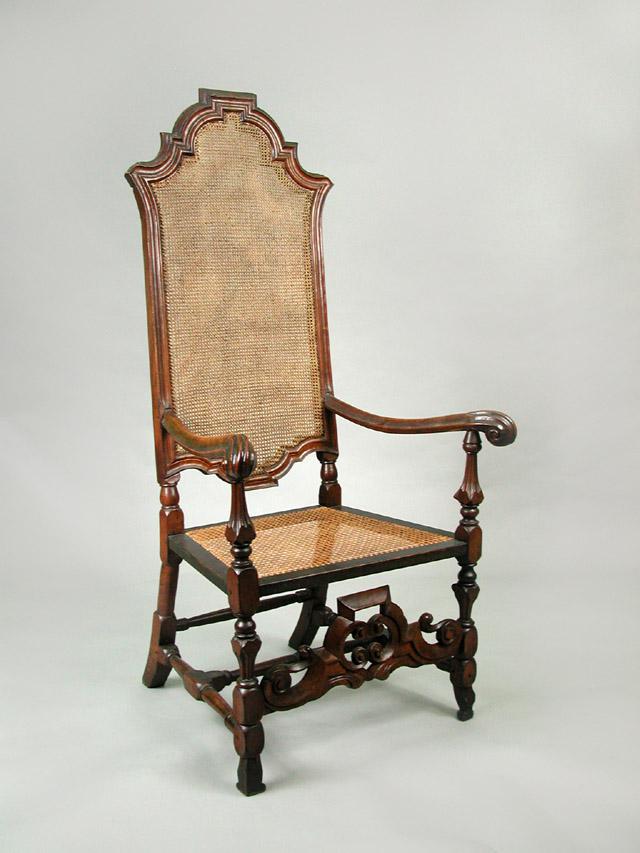Armchair
Furniture MakerMade by
Unknown
Dateabout 1830
MediumButternut, cane
DimensionsPrimary Dimensions (overall height x width x depth): 52 3/4 x 25 1/4 x 25 1/2in. (134 x 64.1 x 64.8cm)
ClassificationsFurniture
Credit LineGift of Daniel Wadsworth, Esq.
Object number1844.69.2
DescriptionButternut reproduction armchair in the William and Mary, or early baroque, style, with an elaborately arched and molded crest rail, a cane back and seat, a carved front stretcher, and turned legs and stretchers. The back of the chair is formed by an arched and molded crest rail atop two stiles. The crest rail has a flat section at the top; to each side, it descends into a projecting quarter circle, a fillet, or horizontal area, and a recessed quarter circle that ends in a point that extends past each stile. The top of each stile extends out to meet the crest rail, then curves inward. Below the crest rail is a woven cane panel which attaches at the bottom to the shaped stay rail. The shape of the stay rail conforms to the shape of the crest rail, but is inverted. The crest rail, stay rail, and each stile have a molded front, consisting of a projecting half circle, or astragal, and a recessed half circle, or cove. Above the seat, each stile angles backward. Below the seat, each stile forms a back leg that curves back, over a turned ball foot. Each arm is bowed down in the center and has an elaborately scrolled handhold that extends well past the top of the front leg. The top surface of each arm has a raised ridge; the top surface of each handhold has multiple raised ridges. Each front leg is turned with ribbed and flared cones, blocks, and baluster forms, over a tapered foot. Above the seat, each front leg supports the arm. The chair has a trapezoidal cane seat; the outside edges of the seat rails have astragal and cove molding. The front of the chair has an elaborately carved and pierced stretcher. The stretcher has a profile similar to the crest rail, and is carved with a symmetrical arrangement of deep C-scrolls. Each side of the chair has one turned stretcher, with a block in the center. The chair has a medial stretcher, connecting the two side stretchers at the block. The chair has a back stretcher, turned with a ring in the center.
Condition: At one time, the back of the chair was lined with green fabric. The left side of the crest rail has broken along the grain and has been repaired. The frame is refinished, and the cane is replaced.
Design and Construction Details: The crest rail is supported on each side by a tenon at the top of the stile. The outward curve at the top of each stile is constructed of extra wood that is laminated to the vertical stile. The stay rail is tenoned into the stiles. A supporting strip of wood is glued to the back of the stay rail; there are multiple small upholstery nail holes in this strip. The back of each arm is tenoned and pinned into the stile. Each front leg is tenoned into the arm above. The furthest projecting portions of each ribbed and flared turned cone form is constructed of wood that is laminated to the main block of the leg. The front stretcher is tenoned and pinned into the front legs. The seat rails, the side stretchers, and the back stretcher have round tenons that extend into the front or back legs. Each side and back stretcher is pinned or screwed into the stile.
Condition: At one time, the back of the chair was lined with green fabric. The left side of the crest rail has broken along the grain and has been repaired. The frame is refinished, and the cane is replaced.
Design and Construction Details: The crest rail is supported on each side by a tenon at the top of the stile. The outward curve at the top of each stile is constructed of extra wood that is laminated to the vertical stile. The stay rail is tenoned into the stiles. A supporting strip of wood is glued to the back of the stay rail; there are multiple small upholstery nail holes in this strip. The back of each arm is tenoned and pinned into the stile. Each front leg is tenoned into the arm above. The furthest projecting portions of each ribbed and flared turned cone form is constructed of wood that is laminated to the main block of the leg. The front stretcher is tenoned and pinned into the front legs. The seat rails, the side stretchers, and the back stretcher have round tenons that extend into the front or back legs. Each side and back stretcher is pinned or screwed into the stile.
Status
Not on view












